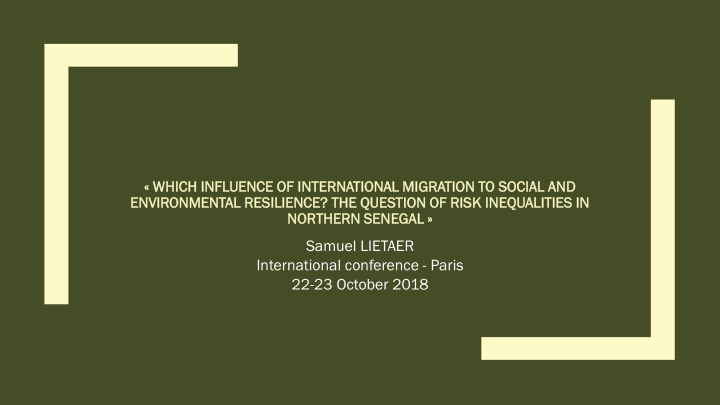



« « WHIC ICH INFL FLUE UENC NCE E OF INTERN TERNATION TIONAL L MIGRA RATION TION TO SOCI CIAL L AN AND EN ENVI VIRONME ONMENT NTAL RES ESIL ILIENCE IENCE? ? THE E QUES ESTION TION OF RISK K INEQU EQUALITI LITIES S IN NORTHERN HERN SEN ENEGAL » » Samuel LIETAER International conference - Paris 22-23 October 2018
Migration as adaption – for whom? : - for the migrants themselves - For the comm mmunity unity of origin in - For the destination community (Gemenne & Blocher, 2017) + ‘ Envi-scapes ’ (from Aduparai; Newman)? 1. Research question and background What is the role of international mobility in terms of adaptation and resilience to environmental changes ? How and to which extent do the communities of origin perceive ive migra rants ts' remit itta tances es (both material and immaterial) as a way to support resilience and adaptation to environmental changes? 2
2. Data and Methodology – 1st Field work in Matam Region ➢ By assess sessin ing g the e exten ent, t, actual ual and nd pot otential ntial end nd us use of remittances mittances (ind ndivid ividual al + c collec lectiv tive) e): : ✓ materia erial remi mittances tances (funds / money, materials, ...) ✓ non-mat ateri erial al remi mitt ttanc ances es (social, political, cultural) ✓ Inves estm tments ents (‘productive’ and ‘non - productive’) ➢ Semi mi-direc rected ed qu questionn estionnai aires res (20 returnees; 88 non-migrants, among which 37 with member abroad) + Focus us groups ups (23) + next year: consolidation – evt. with closed questions (cf MECLEP)? ➢ Direct observation - Mapping of initiatives per category ■ Sampl pling ng (cri riterion erion-based based) : Key resource informants ✓ ✓ Individuals from different economic sectors & activities, with particular attention to agriculture (purposeful; quota; snowballing) ✓ Gender-balanced – in terms of focus groups; but more men for interviews (household heads) 3
3. Key findings and implications Influence of migration on social al vulnerabili rability y to More polit itical ical social-ecological changes: Striking differences repres esenta entation tion in more between households and resilient villages and villages with and (almost) households (remittance- without member ers abroad – interactions) influence ‘winners’ and ‘losers’… agency and structure Conceptual tual relevan ance for combin inin ing : Translocality (cf. Translocal Resilience Sustainable livelihood + + Well-being perspectives? + Political ecology strategies – Schöfberger, 2017)
THANK YOU FOR YOUR ATTENTION ☺ 5
Recommend
More recommend